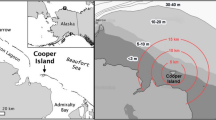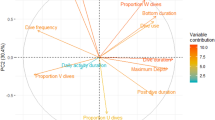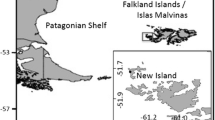Abstract
Seabird foraging behaviour can reflect prey abundance at sea, and is influenced by stress hormone levels, thus providing a potential indicator of at-sea conditions. Using common diving petrels (Pelecanoides urinatrix, hereafter CDPs), a procellariform that preferentially forages on crustacean zooplankton, we sought to understand how spatially separate colonies responded behaviourally and physiologically to contrasting prey levels with a view to recruiting this species as an environmental indicator. In 2016, incubating CDPs from Tiritiri Matangi (− 36.59S; 174.88E, low levels of preferred prey) and Burgess (− 35.91S; 174.12E, high levels of preferred prey) Islands within the Hauraki Gulf, New Zealand, were tracked using GPS devices. We hypothesised that Tiritiri birds would exhibit greater foraging effort and higher stress hormone levels across the breeding season due to lower levels of available prey. Hidden Markov methods were used to model foraging effort, and prey trophic level (stable isotopes: δ13C and δ15N) and stress hormone levels (CORT) quantified in plasma samples. During incubation birds were spatially segregated when foraging. Tiritiri birds exerted more effort, chasing higher trophic level prey at larger distances from the colony, and had higher body weight and lower CORT than Burgess birds. However, bird CORT levels responded more to reproductive duties (peaking during chick rearing) as opposed to colony location, i.e. CORT was not consistently higher in Tiritiri birds. Although a snapshot, our findings illustrate the promise of integrating multiple parameters when recruiting seabirds as ocean indicators, resulting in improved resolution of future monitoring programmes based upon them.





Similar content being viewed by others
References
Adams N, Cockrem J, Taylor G, Candy E, Bridges J (2005) Corticosterone responses of grey-faced petrels (Pterodroma macroptera gouldi) are higher during incubation than during other breeding stages. Physiol Biochem Zool 78:69–77
Bearhop S, Thompson DR, Waldron S, Russell I, Alexander G, Furness RW (1999) Stable isotopes indicate the extent of freshwater feeding by cormorants Phalacrocorax carbo shot at inland fisheries in England. J Appl Ecol 36:75–84
Bearhop S, Waldron S, Votier SC, Furness RW (2002) Factors that influence assimilation rates and fractionation of nitrogen and carbon stable isotopes in avian blood and feathers. Physiol Biochem Zool 75:451–458
Bennison A, Bearhop S, Bodey TW, Votier SC, Grecian WJ, Wakefield ED, Hamer KC, Jessopp M (2018) Search and foraging behaviors from movement data: a comparison of methods. Ecol Evol 8:13–24
Bocher P, Cherel Y, Hobson KA (2000) Complete trophic segregation between South Georgian and common diving petrels during breeding at Iles Kerguelen. Mar Ecol Prog Ser 208:249–264
Burke C, Montevecchi W (2009) The foraging decisions of a central place foraging seabird in response to fluctuations in local prey conditions. J Zool 278:354–361
Cairns DK (1988) Seabirds as indicators of marine food supplies. Biol Oceanogr 5:261–271. https://doi.org/10.1080/01965581.1987.10749517
Camprasse EC, Cherel Y, Arnould JP, Hoskins AJ, Bost C-A (2017) Combined bio-logging and stable isotopes reveal individual specialisations in a benthic coastal seabird, the Kerguelen shag. PLoS ONE 12:e0172278
Carroll E, Gallego R, Sewell M, Zeldis J, Ranjard L, Ross H, Tooman L, O’Rorke R, Newcomb R, Constantine R (2019) Multi-locus DNA metabarcoding of zooplankton communities and scat reveal trophic interactions of a generalist predator. Sci Rep 9:1–14
Cherel Y, Connan M, Jaeger A, Richard P (2014) Seabird year-round and historical feeding ecology: blood and feather δ13C and δ15N values document foraging plasticity of small sympatric petrels. Mar Ecol Prog Ser 505:267–280
Cherel Y, Hobson KA (2007) Geographical variation in carbon stable isotope signatures of marine predators: a tool to investigate their foraging areas in the Southern Ocean. Mar Ecol Prog Ser 329:281–287
Christensen-Dalsgaard S, May R, Lorentsen SH (2018) Taking a trip to the shelf: behavioral decisions are mediated by the proximity to foraging habitats in the black-legged kittiwake. Ecol Evol 8:866–878
Crino O, Buchanan KL, Trompf L, Mainwaring MC, Griffith SC (2017) Stress reactivity, condition, and foraging behavior in zebra finches: effects on boldness, exploration, and sociality. Gen Comp Endocrinol 244:101–107
Crossin GT, Trathan PN, Phillips RA, Gorman KB, Dawson A, Sakamoto KQ, Williams TD (2012) Corticosterone predicts foraging behavior and parental care in macaroni penguins. Am Nat 180:E31–E41
Dean B, Freeman R, Kirk H, Leonard K, Phillips RA, Perrins CM, Guilford T (2013) Behavioural mapping of a pelagic seabird: combining multiple sensors and a hidden Markov model reveals the distribution of at-sea behaviour. J R Soc Interface 10:20120570
Dunphy B, Taylor G, Landers T, Sagar R, Chilvers B, Ranjard L, Rayner M (2015) Comparative seabird diving physiology: first measures of haematological parameters and oxygen stores in three New Zealand Procellariiformes. Mar Ecol Prog Ser 523:187–198
Elliott KH, Le Vaillant M, Kato A, Speakman JR, Ropert-Coudert Y (2013) Accelerometry predicts daily energy expenditure in a bird with high activity levels. Biol Let 9:20120919
Fleming AH, Kellar NM, Allen CD, Kurle CM (2018) The utility of combining stable isotope and hormone analyses in marine megafauna research. Front Mar Sci 5:338
Fry BJ (2002) Stable isotopic indicators of habitat use by Mississippi River fish. Journal of the North American Benthological Society 21:676–685
Garthe S, Montevecchi WA, Davoren GK (2011) Inter-annual changes in prey fields trigger different foraging tactics in a large marine predator. Limnol Oceanogr 56:802–812
Grémillet D, Charmantier A (2010) Shifts in phenotypic plasticity constrain the value of seabirds as ecological indicators of marine ecosystems. Ecol Appl 20:1498–1503. https://doi.org/10.1890/09-1586.1
Grémillet D, Ponchon A, Paleczny M, Palomares M-LD, Karpouzi V, Pauly D (2018) Persisting worldwide seabird-fishery competition despite seabird community decline. Curr Biol. https://doi.org/10.1016/j.cub.2018.10.051
Harding A, Paredes R, Suryan R, Roby D, Irons D, Orben R, Renner H, Young R, Barger C, Dorresteijn I, Kitaysky A (2013) Does location really matter? An inter-colony comparison of seabirds breeding at varying distances from productive oceanographic features in the Bering Sea. Deep Sea Res Part II 94:178–191. https://doi.org/10.1016/j.dsr2.2013.03.013
Harding AM, Piatt JF, Schmutz JA, Shultz MT, Pelt TIV, Kettle AB, Speckman SG (2007) Prey density and the behavioral flexibility of a marine predator: the common murre (Uria aalge). Ecology 88:2024–2033
Harding AM, Welcker J, Steen H, Hamer KC, Kitaysky AS, Fort J, Talbot SL, Cornick LA, Karnovsky NJ, Gabrielsen GW (2011) Adverse foraging conditions may impact body mass and survival of a high Arctic seabird. Oecologia 167:49–59
Harms NJ, Legagneux P, Gilchrist HG, Bêty J, Love OP, Forbes MR, Bortolotti GR, Soos C (2015) Feather corticosterone reveals effect of moulting conditions in the autumn on subsequent reproductive output and survival in an Arctic migratory bird. Proc R Soc B 282:20142085
Henschke N, Everett JD, Suthers IM, Smith JA, Hunt BPV, Doblin MA, Taylor MD (2015) Zooplankton trophic niches respond to different water types of the western Tasman Sea: a stable isotope analysis. Deep Sea Res Part I 104:1–8. https://doi.org/10.1016/j.dsr.2015.06.010
Hobson KA, Clark R (1993) Turnover of 13 C in cellular and plasma fractions of blood: implications for nondestructive sampling in avian dietary studies. Auk 110:638–641
Inger R, Bearhop S (2008) Applications of stable isotope analyses to avian ecology. Ibis 150:447–461
Kitaysky A, Piatt JF, Wingfield J (2007) Stress hormones link food availability and population processes in seabirds. Mar Ecol Prog Ser 352:245–258
Kitaysky AS, Wingfield JC, Piatt JF (1999) Dynamics of food availability, body condition and physiological stress response in breeding Black-legged Kittiwakes. Funct Ecol 13:577–584. https://doi.org/10.1046/j.1365-2435.1999.00352.x
Kokubun N, Takahashi A, Paredes R, Young R, Sato N, Yamamoto T, Kikuchi D, Kitaiskaia E, Ito M, Watanuki Y (2018) Inter-annual climate variability affects foraging behavior and nutritional state of thick-billed murres breeding in the southeastern Bering Sea. Mar Ecol Prog Ser 593:195–208
Lamb JS, Satgé YG, Jodice PG (2017) Influence of density-dependent competition on foraging and migratory behavior of a subtropical colonial seabird. Ecology and Evolution 7:6469–6481
MacDiarmid A, Beaumont J, Morrison M, McKenzie A, Abraham E, Taylor R, Gillanders B, Bury S, Cowles A, Parsons D, Cole R, Pinkerton M, Walker J (2011) Rocky reef ecosystems—How do they function? Integrating the roles of primary and secondary production, biodiversity, and connectivity across coastal habitats. Report prepared for NZ Ministry of Fisheries, Wellington
Madliger CL, Love OP (2016) Conservation implications of a lack of relationship between baseline glucocorticoids and fitness in a wild passerine. Ecol Appl 26:2732–2745
McClintock BT (2017) Incorporating telemetry error into hidden Markov models of animal movement using multiple imputation. J Agric Biol Environ Stat 22:249–269
McClintock BT, Michelot T (2018) momentuHMM: R package for generalized hidden Markov models of animal movement. Methods Ecol Evol 9:1518–1530
Morales JM, Haydon DT, Frair J, Holsinger KE, Fryxell JM (2004) Extracting more out of relocation data: building movement models as mixtures of random walks. Ecology 85:2436–2445
Parsons M, Mitchell I, Butler A, Ratcliffe N, Frederiksen M, Foster S, Reid JB (2008) Seabirds as indicators of the marine environment. ICES J Mar Sci 65:1520–1526. https://doi.org/10.1093/icesjms/fsn155
Pinkerton MH, MacDiarmid A, Beaumont J, Bradford-Grieve J, Francis M, Jones E, Lalas C, Lundquist C, McKenzie A, Nodder S (2012) Changes to the food-web of the Hauraki Gulf during a period of human occupation: a mass-balance model approach. Report prepared for NZ Ministry of Fisheries, 1776650514
Pohle J, Langrock R, van Beest FM, Schmidt NM (2017) Selecting the number of states in hidden Markov models: pragmatic solutions illustrated using animal movement. J Agric Biol Environ Stat 22:270–293
Post DM (2002) Using stable isotopes to estimate trophic position: models, methods, and assumptions. Ecology 83:703–718
Rayner M, Carlile N, Priddel D, Bretagnolle V, Miller M, Phillips R, Ranjard L, Bury S, Torres L (2016) Niche partitioning by three Pterodroma petrel species during non-breeding in the equatorial Pacific Ocean. Mar Ecol Prog Ser 549:217–229
Rayner MJ, Taylor GA, Gaskin CP, Dunphy BJ (2017) Seasonal activity and unpredicted polar front migration of northern New Zealand common diving petrels (Pelecanoides urinatrix). Emu-Aust Ornithol 117:290–298
Rayner MJ, Taylor GA, Gummer HD, Phillips RA, Sagar PM, Shaffer SA, Thompson DR (2012) The breeding cycle, year-round distribution and activity patterns of the endangered Chatham Petrel (Pterodroma axillaris). Emu-Aust Ornithol 112:107–116
Reid K, Croxall J, Edwards T, Hill H, Prince P (1997) Diet and feeding ecology of the diving petrels Pelecanoides georgicus and P. urinatrix at South Georgia. Polar Biol 17:17–24
Roby DD (1989) Chick feeding in the diving petrels Pelecanoides georgicus and P. urinatrix exsul. Antarct Sci 1:337–342
Romero LM, Romero RC (2002) Corticosterone responses in wild birds: the importance of rapid initial sampling. The Condor 104:129–135
Smith GT, Wingfield JC, Veit RR (1994) Adrenocortical response to stress in the common diving petrel, Pelecanoides urinatrix. Physiol Zool 67:526–537. https://doi.org/10.1086/physzool.67.2.30163862
Sorenson GH, Dey CJ, Madliger CL, Love OP (2017) Effectiveness of baseline corticosterone as a monitoring tool for fitness: a meta-analysis in seabirds. Oecologia 183:353–365. https://doi.org/10.1007/s00442-016-3774-3
Storey AE, Ryan MG, Fitzsimmons MG, Kouwenberg A-L, Takahashi LS, Robertson GJ, Wilhelm SI, McKay DW, Herzberg GR, Mowbray FK (2017) Balancing personal maintenance with parental investment in a chick-rearing seabird: physiological indicators change with foraging conditions. Conserv Physiol. https://doi.org/10.1093/conphys/cox055
Wilson RP, Börger L, Holton MD, Scantlebury DM, Gómez-Laich A, Quintana F, Rosell F, Graf PM, Williams H, Gunner R (2020) Estimates for energy expenditure in free-living animals using acceleration proxies: a reappraisal. J Anim Ecol 89:161–172
Xie S, Romero LM, Htut ZW, McWhorter TJ (2017) Stress responses to heat exposure in three species of Australian desert birds. Physiol Biochem Zool 90:348–358. https://doi.org/10.1086/690484
Zeldis J, Willis K (2015) Biogeographic and trophic drivers of mesozooplankton distribution on the northeast continental shelf and in Hauraki Gulf, New Zealand. NZ J Mar Freshwat Res 49:69–86
Zhang JA, Rayner MJ, Vickers S, Landers T, Sagar R, Stewart JR, Dunphy BJ (2019) GPS telemetry for small seabirds: using Hidden Markov models to infer foraging behaviour of common diving petrels (Pelecanoides urinatrix urinatrix). Emu-Aust Ornithol 119:126–137
Acknowledgements
We are grateful to mana whenua iwi of Pokohinu (Burgess) and Tiritiri Matangi Islands for permission to work within these precious sites. MJR acknowledges Wendy Rayner for support during field work. Thanks to Julie Brown, Anna Kilimnik and Josette Delgado at the NIWA Environmental and Ecological Stable Isotope Facility for help with sample preparation and stable isotope analysis. We wish to thank three anonymous reviewers for their efforts in improving the quality of this manuscript.
Funding
Funding for this work came from University of Auckland FRDF grants to BJD, MJR and AJRH (9841/370667) and to BJD, MJR and JZ (9044/3714911). The Institute of Marine Science provided funds for GPS loggers. Stable isotope analyses were funded by Birds NZ grant to BJD and MJR and also by funds from the Auckland War Memorial Museum.
Author information
Authors and Affiliations
Corresponding author
Ethics declarations
Conflict of interest
All authors declare they have no conflict of interest.
Ethical approval
All work was performed under ethics approval granted by the University of Auckland Animal Ethics Committee (approval No 001392) and via a Wildlife Authority granted by the Department of Conservation (38016-FAU).
Additional information
Responsible Editor: V. Paiva.
Publisher's Note
Springer Nature remains neutral with regard to jurisdictional claims in published maps and institutional affiliations.
Reviewed by A. Kato, L. Krüger and an undisclosed expert.
Rights and permissions
About this article
Cite this article
Dunphy, B.J., Vickers, S.I., Zhang, J. et al. Seabirds as environmental indicators: foraging behaviour and ecophysiology of common diving petrels (Pelecanoides urinatrix) reflect local-scale differences in prey availability. Mar Biol 167, 53 (2020). https://doi.org/10.1007/s00227-020-3672-4
Received:
Accepted:
Published:
DOI: https://doi.org/10.1007/s00227-020-3672-4




